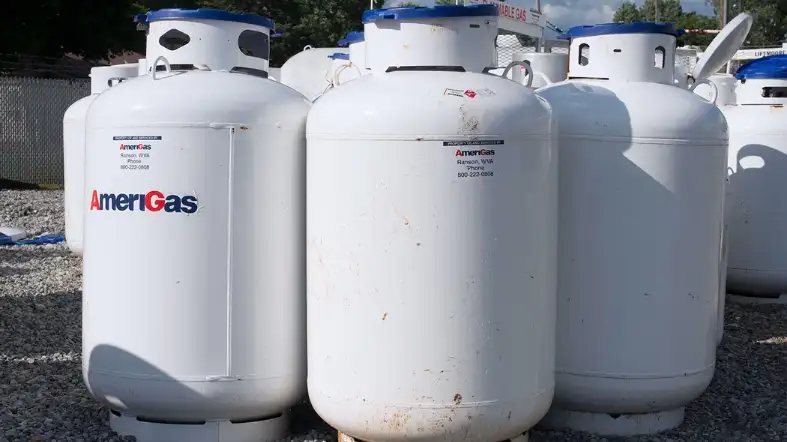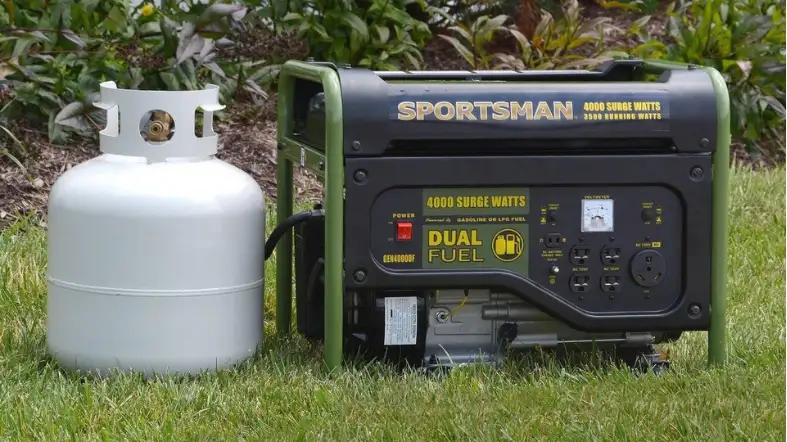Choosing the right size tank can make all the difference in how long your generator can run without needing a refill.
Using the wrong size tank can lead to a shortage of fuel, which can cause your generator to stop working when you need it most. so knowing what size propane tank for Generator is crucial to keep it running.
In this blog post, we’ll explore the factors that influence your propane tank size decision, so you can make an informed choice that meets your power needs.

Click Here To Check Recommended Generators
what size propane tank for the generator?
To power a whole-house generator, you’ll need a propane tank that holds between 100 and 500 gallons of propane. A 100-gallon tank last 1-2 days, while a 500-gallon tank can last 7-10 days. For most home usages, we recommend either a 120-gallon tank for 1-2 days or a 500-gallon tank for 8-10 days.
Generator Size Chart for Propane Tank:
| Generator Power Output | Estimated Run Time | Recommended Propane Tank Size |
|---|---|---|
| 5-7 kW | Up to 10 hours | 20 lb. |
| 8-12 kW | Up to 20 hours | 40 lb. |
| 13-20 kW | Up to 24 hours | 100 lb. |
| 20-30 kW | Up to 48 hours | 250-320 gal. |
| 30-45 kW | Up to 72 hours | 500 gal. |
| 45-60 kW | Up to 96 hours | 1000 gal. |
Factors to consider when choosing the size of a propane tank
When choosing the size of a propane tank for your generator, there are several important factors to consider.
Fuel Consumption Rate
Choosing the right propane tank size is crucial to consider the fuel consumption rate.
This rate depends on the wattage and size of your generator, as well as the number of devices or appliances you’re powering.
Check your generator’s specifications for its fuel consumption rate.
Operating Duration
The duration of operating without refueling is another crucial consideration. This will depend on your specific backup power needs and the time you plan to use it.
A larger propane tank will provide a longer operating time, but it is more expensive and take up more space.
Propane Availability
The availability of propane in your area is also an important factor.
If you have limited access to propane or if delivery times are lengthy, a larger tank can be more practical.
If propane is available and deliveries are frequent, a smaller tank may suffice.
Generator Location and Usage
If you plan to use your generator primarily for emergency backup power at home, a smaller tank can be suitable.
If you plan to use your generator for outdoor events, camping trips, or other off-grid activities, a larger tank is necessary.
Consult with a Propane Professional
The best way to determine the ideal propane tank size is to consult with a licensed propane distributor or installation professional.
They can provide valuable insights into your specific needs and recommend the most practical and cost-effective solution for your situation.
Types of propane tanks for generators

There are several types of propane tanks available for generators, including:
Portable Tanks
Portable propane tanks are smaller in size and easily be transported.
These tanks are suitable for smaller generators and are ideal for outdoor activities such as camping and tailgating.
Stationary Tanks
Stationary propane tanks are larger and designed for permanently installed on your property.
These tanks can hold more propane and provide longer run times for your generator. They are suitable for larger generators and backup power systems.
Underground Tanks
Underground propane tanks are similar to stationary tanks but are installed underground for aesthetic and safety reasons.
These tanks can hold large amounts of propane and provide longer run times for your generator.
Propane Cylinder Tanks
Propane cylinder tanks are small, portable tanks that can be used for generators with low fuel consumption rates.
These tanks are often used as a backup fuel source for smaller generators and are easy to transport and refill.
How to calculate the propane tank size for the generator?

You’ll need to consider the following factors to calculate:
The fuel consumption rate of your generator
This is measured in gallons per hour (GPH) or pounds per hour (PPH). Check the specifications of your generator to determine it.
Desired run time
Determine how long you need your generator to run without refueling. This will depend on your specific backup power needs and time.
Propane tank capacity
The size of the propane tank will determine the amount of fuel it can hold and the time its power.
The most common propane tank sizes for generators are 20 lb., 100 lb., and 500 gallons.
You can use the following formula to calculate the propane tank size for your generator:
(Total Pounds of Propane Needed) = (Fuel Consumption Rate) x (Desired Run Time)
(Total Gallons of Propane Needed) = (Total Pounds of Propane Needed) / (4.24 lbs. per gallon)
For example, if your generator has a fuel consumption rate of 1.5 PPH and want to run for 24 hours without refueling, the total pounds of propane needed would be:
(1.5 PPH) x (24 hours) = 36 lbs.
To convert this to gallons:
36 lbs. / 4.24 lbs. per gallon = 8.5 gallons
In this scenario, a 20 lb. propane tank would not be sufficient, and a larger tank such as a 100 lb. or 500-gallon tank would be more appropriate.
Propane Tank Installation for Generator
Installing a propane tank for your generator requires careful planning and attention to safety.
Here are the general steps involved in propane tank installation for a generator:
Determine the ideal tank size
Calculate the appropriate propane tank size based on your fuel consumption needs, desired run time, and availability of propane in your area.
Keep in mind that the most common propane tank sizes for generators are 20 lb., 100 lb., and 500 gallons.
If you are unsure about the ideal tank size, consult with a licensed propane distributor or installation professional.
Choose the location
Select a location for the propane tank that meets all local zoning and building codes.
The location should be at least 10 feet away from the generator and any ignition sources.
The tank should also be located on a level surface, away from any potential hazards like drainage ditches or underground utility lines.
Prepare the site
Excavate the area where the propane tank will be installed and create a level base for the tank.
The base is made of compacted gravel or concrete and is able to support the weight of the tank.
The hole needs to be at least 6 inches larger than the diameter of the tank and digging deep should be enough to allow.
Install the propane tank
Install the propane tank according to the manufacturer’s instructions and local regulations. The tank should be placed in the hole and leveled.
Backfill around the tank with compacted soil or gravel. Ensure the tank is securely anchored and connected to the generator.
The connection should be made using a flexible hose or a hard pipe, depending on the specific installation requirements.
Install the piping and regulator
Install the piping and regulator according to the manufacturer’s instructions and all local regulations.
The piping should be made of approved materials and should be properly sized for the application.
The regulator should be installed on the tank and properly adjusted for maintaining the correct pressure.
All connections should be properly tightened and sealed with approved fittings.
Test the system
Test the propane tank and generator system to operate properly. Check for leaks by applying a propane leak detector solution to all fittings and connections.
Allow the solution to sit for several minutes and look for any bubbles, which would indicate a leak. Ensure the system is properly vented to prevent the build-up of gas.
Obtain necessary permits
Obtain all necessary permits and inspections from local authorities before operating your propane tank and generator.
This may include permits for excavation and propane tank installation, as well as inspections for proper installation and operation.
Maintenance of Propane Tanks

Propane tanks are built to last for a long time, but proper maintenance is needed for their safety and efficiency. Here are some tips for maintaining your propane tank:
Regular Inspections
Inspect your propane tank regularly for its good condition. Look for signs of rust, dents, or other damage that may affect its structural integrity.
Check the valves and fittings for any signs of corrosion or wear, and ensure the proper tightening.
Keep it Clean
Keep your propane tank clean and free of debris. Dirt leaves and other debris can accumulate around the tank and block the vent or damage the exterior.
Regular cleaning will help prevent this and ensure the tank’s operating efficiently.
Protect it from the elements
Protect your propane tank from the elements. Extreme weather conditions can damage the exterior of the tank, and moisture can cause corrosion.
Use a cover to protect the tank from direct sunlight, rain, and snow.
Schedule Maintenance
Schedule regular maintenance for your propane tank with a licensed propane distributor or installation professional.
They can perform a more detailed inspection and the tank is operating at peak efficiency.
Replace Damaged Parts
If you notice any signs of damage or wear, replace the damaged parts.
Faulty valves or fittings can lead to leaks or other safety hazards, so address any issues as soon as possible.
FAQs on the right size propane tank for the generator
How Often Should I Have My Propane Tank Inspected?
Propane tanks should be inspected regularly for signs of damage or wear.
A licensed propane distributor or installation professional can recommend a maintenance schedule based on your tank’s usage and environmental conditions.
How Long Will A Propane Tank Last For My Generator?
The duration of a propane tank for your generator depends on the tank size, the generator’s fuel consumption rate, and the expected duration of the operation.
A licensed propane distributor or installation professional can assist you in selecting the appropriate tank size for your generator.
Can I Use A Propane Tank For Other Appliances Besides My Generator?
Yes, propane tanks can be used for other appliances such as grills, heaters, and stoves.
Consider the energy requirements of each appliance and select an appropriate tank size.
How Do I Know If My Propane Tank Is Empty?
Propane tanks have a gauge that indicates the level of propane remaining.
Check the gauge regularly to ensure the tank doesn’t run out of propane during use.
Propane tanks can emit a sulfur-like odor when the propane level is low, which serves as a warning to refill the tank.
Final Words
Selecting the appropriate propane tank size for your generator is crucial for ensuring its safe and efficient operation.
The generator’s energy requirements, fuel consumption rate, and expected duration of operation should be considered when choosing the tank size.
Regular maintenance of the propane tank is also necessary to ensure its longevity and safety.
Consulting with a licensed propane distributor or installation professional is highly recommended to ensure that all safety regulations are followed during installation and usage.
